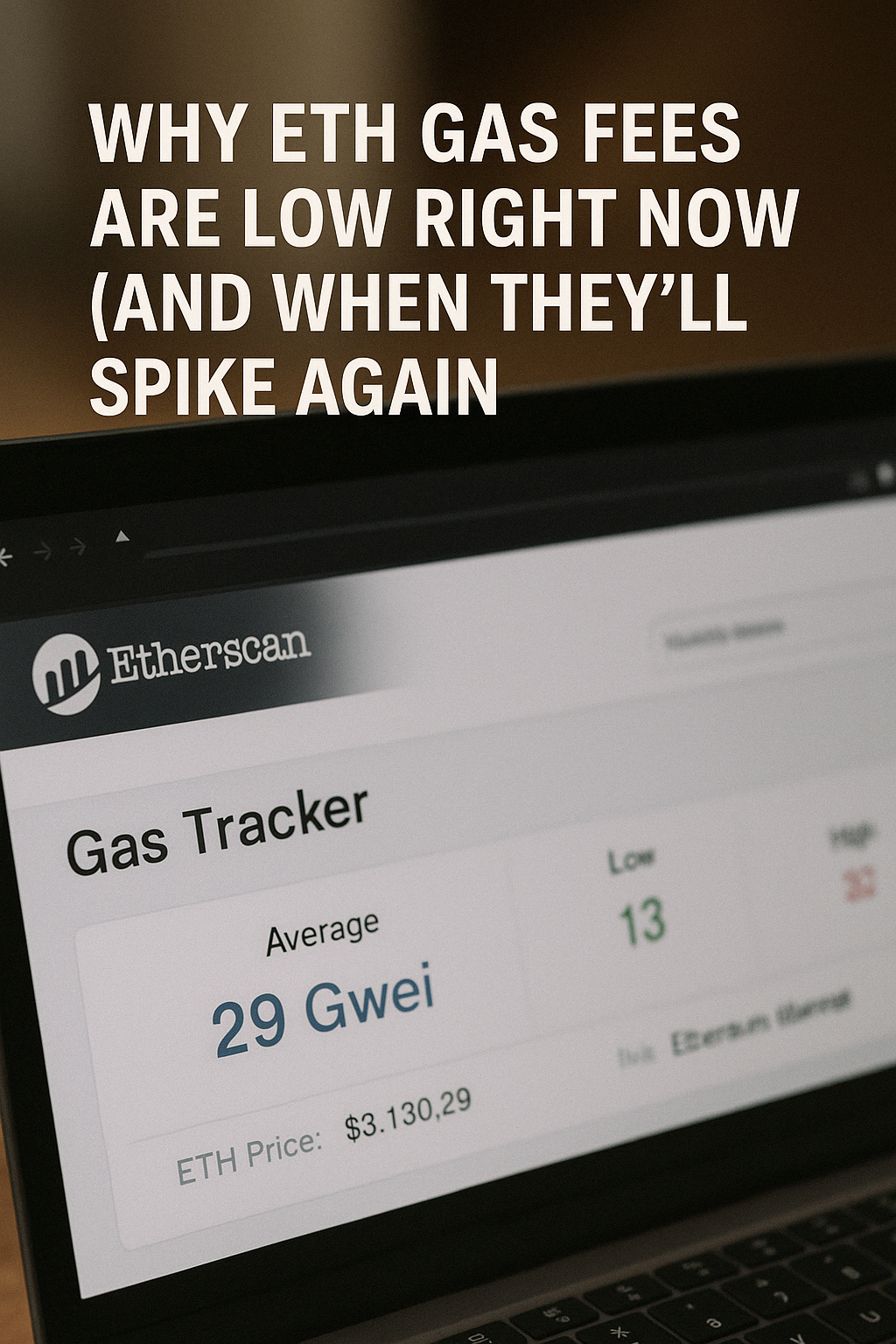Why ETH Gas Fees Are Low Right Now (and When They’ll Spike Again)

ETH gas fees, once a major hurdle for Ethereum users, are surprisingly low right now. Whether you’re swapping tokens, minting NFTs, or just sending ETH, lower gas fees mean more affordable transactions on the Ethereum gas network.
But is this just a temporary relief? In this SEO-optimized blog, we’ll break down why ETH gas is cheaper than usual, when it might spike again, and how you can take advantage of this lull. We'll also cover bonus FAQs on tokenization in real estate and blockchain applications to expand your understanding of this powerful ecosystem.
🔍 What Are ETH Gas Fees?
ETH gas fees are transaction costs paid to validators for securing and processing transactions on the Ethereum network. These fees are measured in gwei, a fractional unit of ETH.
Gas isn’t just for transfers — it’s required for:
Smart contract interactions (like DeFi)
NFT minting
Token swaps
Decentralized voting
High Ethereum gas fees are a result of limited block space during times of high demand. But recently, those bottlenecks have eased.
🧊 Why Are Ethereum Gas Fees Low Right Now?
1. Less Network Congestion
There’s been a cooldown in blockchain activity, with fewer major NFT drops or DeFi rushes. This has eased congestion and lowered base gas prices.
2. Adoption of Layer 2 Networks
Projects like Arbitrum, Optimism, and zkSync reduce reliance on the Ethereum mainnet by processing transactions off-chain and settling them in batches.
3. Better dApp Efficiency
Top apps now batch operations and reduce redundant contract interactions, lowering individual gas costs.
4. Post-EIP-1559 Mechanisms
The EIP-1559 upgrade introduced a base fee burn model, making gas price estimation more predictable and less volatile.
📈 When Will ETH Gas Fees Spike Again?
While fees are low now, they won't stay that way forever. Here’s when to expect a surge:
🚀 Crypto Market Rallies
Bull runs draw in new users and capital, driving up Ethereum gas fees as usage spikes across DeFi, NFTs, and exchanges.
🎨 Popular NFT Launches
NFT mints from blue-chip projects (like Yuga Labs or Azuki) often lead to gas wars, where users compete for block space.
📊 New Protocol Hype
When the next big DeFi app goes live or a memecoin trend catches on, gas usage can explode.
🛠️ Delayed Ethereum Upgrades
Until full sharding is implemented, Ethereum will still face scalability limits. Delays in this could create future bottlenecks.
💡 When Is ETH Gas Cheapest?
Knowing when to transact is key to saving on gas fees. Here's what to watch:
| Time (UTC) | Reason It's Cheap |
|---|---|
| 2AM–6AM | Fewer users in the U.S. and Europe |
| Saturday/Sunday | Lower weekday DeFi/NFT activity |
| Post-event | After major drops or crashes |
Use tools like Etherscan Gas Tracker or GasNow to monitor real-time prices.
🛠️ How to Reduce ETH Gas Costs
✅ Use Layer 2 solutions like Arbitrum or Optimism.
✅ Time your transactions during low activity periods.
✅ Batch interactions where possible.
✅ Use gas-optimized dApps like Uniswap v4 or 1inch.
Pro tip: Some wallets like MetaMask now auto-suggest optimal gas settings.
🧠 People May Know Questions
❓What is the tokenization of real estate using blockchain?
Tokenization converts real estate assets into digital tokens on a blockchain. These tokens represent ownership rights and can be traded on secondary markets. This lowers entry barriers for small investors and makes real estate more liquid.
❓How is blockchain used in the real estate industry?
Blockchain enables:
Smart contracts for auto-executing property sales
Digital title records with tamper-proof history
Tokenized ownership for shared real estate investment
Faster, cheaper transactions without intermediaries
❓Is tokenization the same as blockchain?
Not exactly. Blockchain is the underlying technology — a decentralized ledger. Tokenization is a use case that leverages blockchain to represent physical or digital assets as tradeable tokens.
🔮 The Future of Ethereum Gas Fees
Ethereum’s roadmap includes:
✅ Sharding: Splits the blockchain into parts to improve scalability.
✅ Proto-danksharding (EIP-4844): Reduces data overhead and costs.
✅ Deeper Layer 2 Integration: More apps shifting to rollups.
In the long run, Ethereum may handle 100k+ transactions per second, drastically reducing gas.
⚠️ Disclaimer
This article is for educational purposes only. It does not constitute financial advice or an endorsement of any investment strategy. Always do your own research and consult with a licensed financial professional before making any investment decisions in the cryptocurrency space.
📝 Conclusion
For now, enjoy the low ETH gas fees — but be prepared for volatility. By understanding when Ethereum gas is cheapest, using Layer 2s, and keeping up with Ethereum's upgrades, you can transact more efficiently and economically.
And if you're eyeing blockchain applications beyond crypto? Tokenized real estate, smart contracts, and fractional ownership are already reshaping traditional markets.